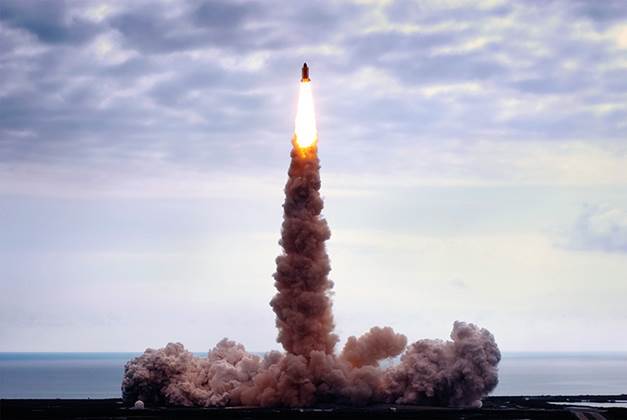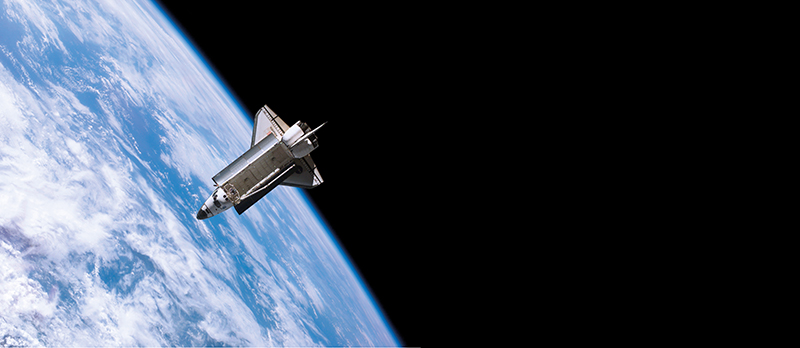Photo Book Honors NASA's Space Shuttle Program

A photographic image retoucher turned his artistic eye to the space shuttle program, generating a book with decades-old images that look like they were taken in the digital age.
Graphic designer Luke Price's "Space Shuttle: A Photographic Journey 1981-2011" (Ammonite Press, 2019) includes a selection of shuttle imagery across dozens of missions, from launch to landing. The book — which Price first dreamed up in 2009 — took him four years to put together, due to the large number of images to review, and because he needed to fix up some damaged prints, he said in an interview.
"Many of the photos directly supplied from NASA had damage caused from the original NASA files," Price told Space.com. "I worked extensively to achieve a level that hadn't been published before with regards to space shuttle exploration, and NASA assisted me whenever I needed by supplying high-res photographs and putting me in touch with any contacts I needed."
Related: Best Space Books and Sci-Fi for 2019
The book comes in two versions: a standard edition (widely available now) and a limited "Chris Ferguson" edition with a special slipcase, a signed certificate from the space shuttle astronaut, black page edges and more unique features. It is limited to only 135 copies — honoring the 135 missions of the space shuttle program — and is available at https://www.spaceshuttlebook.com.
It started with Challenger
The space shuttle program ran for 30 years and pioneered many aspects of spaceflight today. Astronauts practiced experiment-driven missions, focusing on science- and health-oriented tasks in space that are similar to what crews do today on the International Space Station. Crews perfected the techniques of spacewalks, which they used to repair satellites, including the Hubble Space Telescope, and to literally build the ISS. And the space shuttle taught NASA how to operate a program for a long period of time, laying the foundation for the space station's current 20 years of human operations.
Price's interest in the space shuttle program began during one of its most tragic moments. He was among the thousands of schoolchildren watching the televised launch of teacher Christa McAuliffe, along with the rest of the space shuttle Challenger crew, on Jan. 28, 1986. The shuttle exploded during liftoff due to a problem with the booster tanks, forcing a lengthy safety review. The shuttle returned to flight in 1988.
Breaking space news, the latest updates on rocket launches, skywatching events and more!
Price continued following the space shuttle's exploits while diving into the history of human space exploration, all the way back to the Mercury program in the early 1960s. (He describes one of his biggest influences as the 1983 movie "The Right Stuff," which portrays some of the earliest crewed missions.) As he grew older, he realized that books about the shuttle program were largely technical in nature, and he decided to take a different direction.
Generating interest
Price said it frustrated him that the general media rarely covered the space shuttle program in its latter years. His aim in creating the book is to show the wonder of a typical shuttle mission, with the benefit of having reviewed untold thousands of photographs of the program to pick the very best.
Ironically, it was because of the Columbia disaster that Price found some of his favorite images from orbit. Because the cause was in part traced to vital protective tiles knocked loose during launch, NASA required all crews to scan the shuttle's belly for missing tiles after every launch, using robotics and a new approach procedure to the ISS. "The shuttle would go through a series of maneuvers, and fly around the International Space Station, and the crew on board … would photograph the shuttle from lots of different angles and relay that photography down to Houston," Price explained.
While working on the project, Price was in touch with several astronauts, including Bruce McCandless, who first flew the "jetpack," or Manned Maneuvering Unit, that shuttle crews used in the early 1980s to retrieve satellites. Price was deciding whether to use McCandless' famous images on the cover, and met with the astronaut two or three times to discuss permissions. McCandless died at age 80 in 2017, and Price eventually decided on a different cover "for artistic reasons," but some of McCandless' words are in the latest edition of Price's book.
Price said he hopes the book shows the public the value of the space shuttle program, especially in terms of its scientific accomplishments. "I don't think people realize the amount of scientific research that comes out of the space shuttle missions, specifically on a medical front," he said, pointing out that the biomedical research that was conducted helped them to develop techniques for the space station and to work on ongoing medical research projects on Earth involved in aging and other pressing problems.
You can buy Space Shuttle: A Photographic Journey 1981-2011 on Amazon.
- 10 Amazing Space Shuttle Photos
- Photos: Rare Last Look Inside Shuttle Atlantis
- Earth From Space: Classic NASA Photos (Gallery)
Follow Elizabeth Howell on Twitter @howellspace. Follow us on Twitter @Spacedotcom and on Facebook.

Elizabeth Howell (she/her), Ph.D., was a staff writer in the spaceflight channel between 2022 and 2024 specializing in Canadian space news. She was contributing writer for Space.com for 10 years from 2012 to 2024. Elizabeth's reporting includes multiple exclusives with the White House, leading world coverage about a lost-and-found space tomato on the International Space Station, witnessing five human spaceflight launches on two continents, flying parabolic, working inside a spacesuit, and participating in a simulated Mars mission. Her latest book, "Why Am I Taller?" (ECW Press, 2022) is co-written with astronaut Dave Williams.


